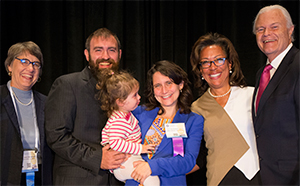Paula Anne Newman-Casey, MD, MS, is the Academy’s Artemis Award winner for young ophthalmologists this year, recognized for her community outreach and her efforts to improve patient education programs in the Metro-Detroit area.
As a resident, fellow and now faculty member at the University of Michigan, Dr. Newman-Casey has championed the needs of the region’s poor and underserved, spearheading a collaboration between the university, its W.K. Kellogg Eye Center and the Hope Clinic to provide free ophthalmic care to uninsured patients. She’s also worked to personalize patient education in a way that recognizes an individual’s diversity and sought out innovative ways to use technology for improving medication adherence.

Dr. Newman-Casey accepts the 2016 Artemis Award at AAO 2016. From left to right: Susan Day, MD, SO Committee chair; Dr. Newman-Casey with family; Tamara Fountain, MD, secretary for member services; and Bill Rich, Academy president.
She accepted the Artemis Award during the AAO 2016 YO Program in Chicago. She is the third winner of the award, which the Academy started in 2014.
Dr. Newman-Casey attributes a large part of her career success — and inspiration — to the patients at the Hope Clinic, a non-profit clinic in Washtenaw County, MI, that provides about 11,000 free medical and dental visits to 3,700 uninsured, low-income residents each year.
“These patients are facing a huge source of stress if they are unable to find the necessary resources to help with whatever medical problems pop into their lives,” she said. “My experiences with them have made me work harder in the hope that our medical system can find a better way to take care of each individual in their time of need.”
In addition to her patients, Dr. Newman-Casey also draws inspiration from her early undergraduate education at Reed College in Portland, OR — a unique institution best known for a mandatory humanities curriculum and a student-run nuclear reactor.
“It really is a place that encourages people to ask why and see the world around them through the eyes of each individual’s experience,” she said.
And this spirit of inquiry continues to inform her role as a caregiver. “I approach my patients with continuous curiosity, wondering what it’s like to experience health and disease through their unique viewpoints. And the same goes with my research: Will this new approach work? Will it improve care? I was lucky to attend Reed College where that curiosity was stoked.”
This curiosity has, in turn, stoked a tireless work ethic. On one occasion, Dr. Newman-Casey was able to generate enough excitement about the Hope Clinic that more than 100 staff from the Kellogg Eye Center donated their time on a Saturday morning to see the uninsured. This group included a party of 32 faculty members, 20 residents, 44 technicians, 24 clerks, five financial counselors and seven opticians.
“She’s served as a perfect role model for physicians in our community,” said Jean B. Cederna, MD, Hope Clinic’s medical director. “She was able to identify all of the potential challenges that can adversely impact these patients’ care — including transportation issues, poor time management skills and the dietary effects of poverty — and showed everyone the power of charity and volunteerism.”
The Academy’s senior ophthalmologist committee created the Artemis Award in 2014 to recognize just that: exemplary service by young ophthalmologists that goes above and beyond what’s required or expected. Ophthalmology department chairs and program directors, along with state, subspecialty and specialized interest societies are solicited annually to submit nominations of exemplary YOs.
For Dr. Newman-Casey, this kind of service doesn’t have to be an exception to the rule. “If you are truly interested in helping those who don’t have access to care, there are many successful options out there,” she said. “Whether it be collaborating with free clinics, helping people access insurance or donating services in a private practice or academic setting — the bottom line is that anyone can make a difference.”
Paul P. Lee, MD, JD, director of the W.K. Kellogg Eye Center, has seen day in and day out just what kind of difference she has made. “YOs should recognize that Paula Anne was inspired to do all of this work with the Hope Clinic — whether it be securing volunteer staff, organizing specialty care or obtaining free eye glasses — while she was a resident,” he said. “It’s truly an example for all young folks in training that you don’t actually have to be a faculty member to effect change and make important things happen.”
* * *
About the author: Mike Mott is a former assistant editor for EyeNet Magazine and contributing writer for YO Info.